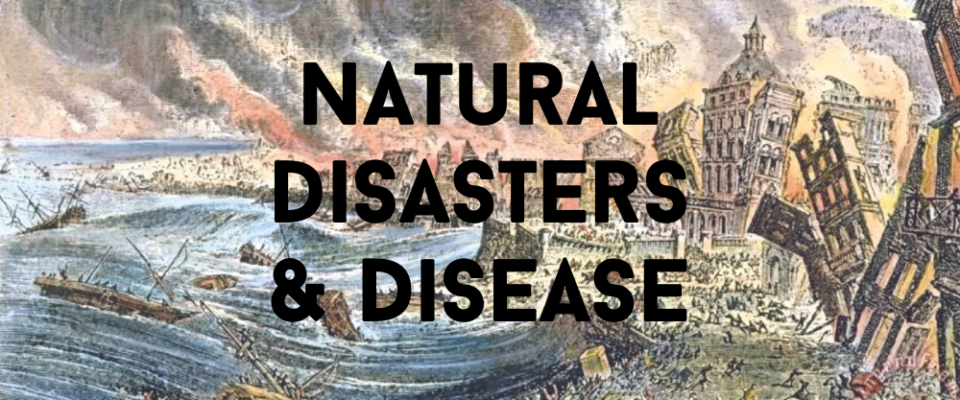Questions
How has St. Petersburg been affected by floods and cholera? How has the Neva River played a role in both cases?
What measures were taken to eliminate these problems or mitigate their effects? Were they successful?
What were people’s reactions towards measures taken by the authorities?
What are some of the connections between the issue of cholera and floods?
Cholera and Floods in St. Petersburg
St. Petersburg, the former capital city of Russia, has had arduous and lengthy battles against diverse natural hazards and epidemic disease. This report mainly focuses on cholera and floods, which are both water-related issues, in St. Petersburg during the time of the Russian Empire. This is a story about the Neva River, gradual improvements, repetitive mistakes and slow responses, and a turbulent society.
In order to dig into cholera and floods in St. Petersburg, it is necessary to briefly introduce the Neva River first. St. Petersburg is known as the Venice of the North (Barabanova & Kraikovski 2018, 163), reflecting its close relation to water. The Neva is the backbone of the city: all Petersburg residents, including the ruling family, used the river for household water consumption (Barabanova & Kraikovski 165-166). Nonetheless, the Neva has not only provided convenience but also brought disasters to daily lives.
The cholera epidemic in St. Petersburg started with a small fishing boat, which arrived in the city on May 28, 1831. On June 14, a passenger was confirmed to have been diagnosed with cholera (Barabanova & Kraikovski 166). Although the passenger recovered, a painter’s workman died from the disease on the same day (Barabanova & Kraikovski 172). These two cases mark the formal outbreak of cholera in St. Petersburg. From June 14 to November 5, among the 9245 people who caught the disease, 4757 people died (Barabanova & Kraikovski 172). The high mortality rate suggests the terrifying situation inside the city at that time. According to Steinberg, whose work concentrates on the chaotic Petersburg society during the last years of the Russian Empire, cholera had made St. Petersburg a “capital of death.” (Steinberg 2011, 129) Like many other cities around the world that encountered the epidemic, the glorious St. Petersburg had fallen. Then the important questions are, what caused the rapid expansion of cholera in St. Petersburg, and what measures were taken?
Steinberg points out that polluted environment, including water and soil, ineffective public sanitation system, inadequate hospitals, unprepared and disorganized city administration, and ignorant and helpless residents together expedited the expansion (Steinberg 129). Barabanova and Kraikovski, on the other hand, provide similar answers with a more specific focus: the Neva. Like Steinberg, they state that poor sanitary conditions triggered the spread of cholera in St. Petersburg, but they further emphasize that both regular floods of the Neva and the Neva’s pollution contributed to the poor sanitary conditions (Barabanova & Kraikovski 172 & 178). Furthermore, “the Neva provided the gate for the disease.” (Barabanova & Kraikovski 178) From the 1820s to 1830s, a lot of factory workers poured into St. Petersburg through the Neva, making the city overcrowded (Barabanova & Kraikovski 178). By providing these examples, Barabanova and Kraikovski stress the important role of the Neva in the spread of cholera. The river that the Petersburg people relied on had aggravated the crisis.
Measures were taken to try to solve the problem, but they were not that successful. Realizing that cholera was contagious, capital authorities blocked the waterways and established overland and coastal quarantines (Barabanova & Kraikovski 170). The authorities also constructed temporary cholera hospitals (Barabanova & Kraikovski 175). Nonetheless, despite these efforts, like Steinberg, Barabanova and Kraikovski point out how disorganized and inexperienced the city administration and hospitals were. Involuntary admission and the unprepared cholera hospitals led to riots that caused the destruction of hospitals and casualty of doctors. The most well-known one was the riot at Haymarket Square, Sennaia Ploshchad’, which even forced Emperor Nicholas I to face the crowd. Moreover, during the first epidemic of 1830-1831, the city authorities did not work on improving the sanitary conditions or cleaning the rivers and canals at all (Barabanova & Kraikovski 176). Therefore, it is fair to say that the measures taken during the first epidemic were total failures. Yet, failures also became learning experience. During the second epidemic of 1847-1849, there was no more involuntary hospitalization, and in addition to temporary cholera hospitals, the civil hospitals also opened wards for cholera patients (Barabanova & Kraikovski 176). These measures succeeded in preventing people from starting cholera riots and assisting patients to receive treatments in time. There was indeed a number of gradual improvements.
Unfortunately, the improvements were insufficient. During the first two epidemics, “the issues of water purification or the threat of the Neva’s water were not raised[,]” (Barabanova & Kraikovski 178) suggesting that the city authorities continuously ignored the problem of the Neva. From 1908 to 1909, about 6,100 people still died from cholera, and this recurrent disease was called the “enemy.” (Steinberg 122) Steinberg’s work highlights that towards the last years of the Russian Empire, cholera was still an ongoing issue in St. Petersburg. There were ameliorations since the first outbreak, but the repetitive failures should not be neglected.
Floods in St. Petersburg are another story, but a story that shares similarities and connections with that of cholera. Due to the city’s close proximity to the Neva, floods had become common. According to Kosterin and Shchekachikhin, whose article was published in 2017, there had been 308 floods in St. Petersburg since 1703 (Kosterin & Shchekachikhin 2017, 371). Although floods were a common phenomenon, they occurred irregularly. For example, there were five floods in 1752, but there were none between 1729 and 1732, and 1744 and 1752 (Nazarenko & Smirnova 2021, 279). Among all the floods that had happened, this report targets one flood specifically. That is the 1824 St. Petersburg flood, one of the most devastating floods in history of the city.
On November 7, 1824, a cyclone in the Baltic Sea pushed the Neva’s water upstream into St. Petersburg. During the flood, at least 700 people died (Dills 2014, 480). Dills, whose article analyzes the relationship between the 1824 flood and the autocratic state and authorities, suggests that “[c]ontrol of the river was central to the state’s grand image and its awesome display of power.” (Dills 488) Therefore, “[t]he 1824 flood shattered faith in the autocratic regime’s ability to protect the city and demonstrated that infrastructure needed reconstruction.” (Dills 487) In other words, the destructiveness of the flood directly undermined people’s trust in the state and authorities, as their precautions had not protected residents from the disaster as promised. Authorities needed to take measures immediately.
During reconstruction, the officials made decisions on whether to relocate certain houses and churches or not based on careful analyses of each condition (Dills 486). The city leaders also recorded the height of water on streets, warning the residents to evacuate from dangerous areas when floods were about to come (Dills 490-491). Despite these efforts and improvements, similar to the case of cholera, the official responses in imperial Russia were generally dissatisfactory. In fact, long before the 1824 flood, in 1727, a Danish engineer named Burkhardt von Minikh had advised the construction of a dam to prevent flood, but this project was never realized (Dills 488). If the dam had been established, perhaps the 1824 flood would not have been that destructive. Sadly, the same story occurred once again. In 1824, engineer P. Bazin developed a dam project, but the authorities turned it down since they found it impracticable. As a result, the first dam project in St. Petersburg did not start until 1979 (Nazarenko & Smirnova 279). The construction of the St. Petersburg Flood Protection Barrier System, also known as FPBS, took more than thirty years since its initiation in 1979 (Kosterin & Shchekachikhin 372 & 375). The system contains six spillways, two navigational passages and eleven protective dams (Kosterin & Shchekachikhin 371-372), and it has proven to be a successful hydraulic engineering project (Kosterin & Shchekachikhin 376). Nazarenko and Smirnova also claim that the floods have been overcome (Nazarenko & Smirnova 281). Nevertheless, this success is a little too late for Petersburg residents back to the Russian Empire, who never had the opportunity to be protected by a dam due to the slow official responses.
After reading these five sources, I find a number of similarities and connections between the story of cholera and floods in imperial St. Petersburg. Firstly, the Neva River played a significant role in both cases as previously suggested. Secondly, both cholera and floods were protracted problems due to repetitive mistakes or neglect and slow responses from the authorities. Thirdly, they triggered unsettling and angry emotion among the general population, pushing them to question the royal family and authority figures. When Nicholas I had to stand out to face the public after the riot, when people expressed distrust after the 1824 flood, the status of the emperorship and authority was shaken.
In conclusion, in the case of St. Petersburg, it is valuable to discuss cholera and floods at the same time. They were not only natural hazard and epidemic disease, but also reflections of a turbulent, chaotic society.
Bibliography
Barabanova, Kseniya, and Alexei Kraikovski. “The Management of Cholera Epidemics and the Neva River in St. Petersburg in the Nineteenth Century.” Water History 10 (2018): 163-181. https://doi.org/10.1007/s12685-018-0219-4.
Dills, Randall. “Cracks in the Granite: Paternal Care, the Imperial Façade, and the Limits of Authority in the 1824 St. Petersburg Flood.” Journal of Urban History 40, no.3 (2014): 479-496. DOI: 10.1177/0096144213508624.
Kosterin, N.V., and V. I. Shchekachikhin. “St. Petersburg Flood Protection Barrier System: First Years of Operation.” Power Technology and Engineering 51, no.4 (November 2017): 371-376. DOI 10.1007/s10749-017-0841-9.
Nazarenko, Kirill B., and Maria A. Smirnova. “St. Petersburg Port through Disasters: Challenges and Resilience.” Journal of Urban History 47, no.2 (2021): 272-292. DOI: 10.1177/0096144219877864.
Steinberg, Mark D.. Petersburg Fin de Siècle: The Darkening Landscape of Modern Times, 1905-1917. New Haven & London: Yale University Press, 2011. https://www-jstor-org.proxy.library.georgetown.edu/stable/j.ctt5vm7nw.

